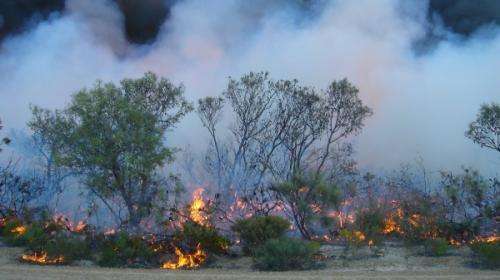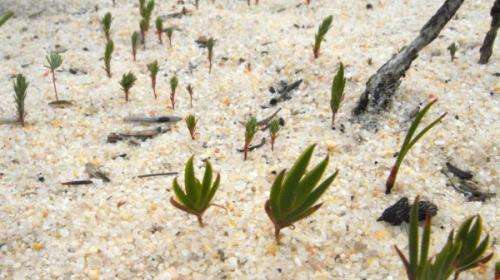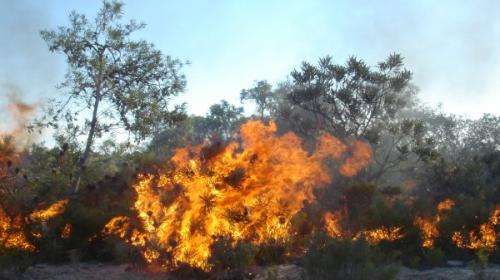Height better than age when predicting fire fuel load

Plant height is a stronger predictor of fuel load than fuel age in diverse shrublands, a West Australian study has found.
The study aimed to identify a simple and accurate method for estimating fuel load in WA shrublands.
Lead author and Bush Heritage Australia regional ecologist Dr Vanessa Westcott says land managers commonly use fuel age maps, which track years since the last fire, to predict fire behaviour when planning prescribed burns.
However, these maps are limited in their ability to provide accurate fuel load information, since they do not capture differences in species composition, Dr Westcott says.
These differences can change the way shrublands bounce back after fire, leading to differences in the fuel load they accumulate.
"We have quantified this variability in fuel loads and have been able to determine that measuring plant height provides a more accurate fuel load estimate than fuel age," Dr Westcott says
"We have also developed an easy method for managers to apply this knowledge, and make more accurate fuel load estimations in the future."
Resprouters vs seed regenerators
Dr Westcott conducted her study in shrublands in the Eneabba region, 270km north of Perth, due to the area's vast range of plant species.

"These shrublands are rarely dominated by a single species but rather an ever-changing mix of species, making fuel load estimation difficult."
She says different plant species regenerate after fire in different ways, as shown in the Eneabba sandplain and adjacent sand-over-limestone shrublands.
"On the Eneabba sandplain, there is a subtle dune-swale system, which results in differences in the species present," she says.
"The higher ground (dunes) support larger shrub species and accumulate more fuel compared to low-lying depressions (swales) where plants are smaller.
"These differences relate to greater year-round root access to soil moisture on the dunes allowing larger shrub species to establish."

Dr Westcott says the fuel loads of the sand-over-limestone plant community have higher proportions of single-stemmed species, which regenerate from seed.
"In recently burnt vegetation, species that regenerate from seed accumulate fuel more slowly than those that are able to resprout," she says.
"Therefore, the proportion of species present which regenerate in these different ways can influence the rate that fuel loads accumulate.
"Soil nutrients are also important in determining the types of species present and the rate at which they regenerate after fire."
The findings are published in the International Journal of Wildland Fire.
More information: "Biomass and litter accumulation patterns in species-rich shrublands for fire hazard assessment." International Journal of Wildland Fire 23(6) 860-871 dx.doi.org/10.1071/WF13006
Provided by Science Network WA


















